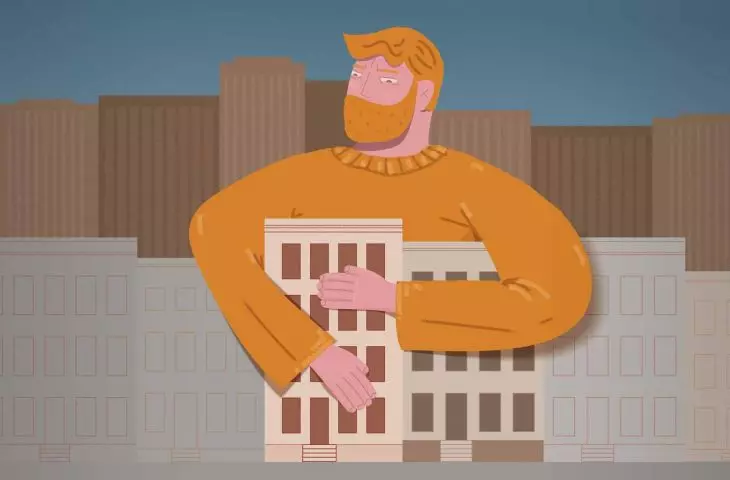Probably each of us has found in the mailbox a card with the words "I will buy an apartment for cash", perhaps also in a more personal variant, where a young couple introduces themselves, and in support of their credibility the card is accompanied by a drawing of a house. Such advertisements are, of course, the methods of flippers who want to buy an apartment as cheaply as possible, renovate it and resell it at a pretty good profit. The problem is that young couples are really looking for an apartment, but they are losing out in the free-market real estate race.
Housing prices are rising and there is unlikely to be a change on the horizon. Even Dom Development ' s CEO Jaroslaw Szanajca pointed out at the Q3 2023 earnings conference that housing prices are rising too fast. He admitted that the price increase we faced last year was an increase that was too high for the Polish market. On the other hand, according to the CSO's latest census, there are almost 70,000 unoccupied apartments in Krakow alone. Although the actual scale of the problem seems a bit smaller, because included here are units that are being finished, but also those whose owners have emigrated, or units whose technical condition does not allow for permanent residence. A sizable portion, however, is made up of apartments bought for investment, the purchase of which is expected to pay off in an increase in value. A recent OKO.press article calculated that 45 percent of MPs have more than one apartment (or house), and one in five has at least three residential properties. According to estimates, the number of missing apartments in the capital of Malopolska settles at around 100,000. Krakow is struggling with problems similar to other large cities in Poland. Resorts attract with their academic offer, jobs, quality of life, but living in the city has become something exclusive. Those who lose the most here are those who simply can't afford an apartment. And there is a whole spectrum of users.
An apartment, but for whom?
Last summer the situation of students was loudly discussed, in Poznan there was even an occupation of the "Jowita" dormitory, which was to be taken out of service due to its technical condition. Warsaw University, too, became a place of discussion. Student people here mentioned that there were places in dormitories for only 5 percent of the students, and even so there were not enough places for those meeting income criteria. Rental prices on the private market were unattainable, so in order to continue their studies they turned to the solutions of living with several people in a room or staying overnight in a car. It could be argued that, after all, studying is not for everyone. Sure, it isn't. However, the income criterion should not be an acute factor indicating the possibility of studying. It also determines our other decisions, already as young adults. It is the price per square meter that is the main guideline in the search for a place to live. And the farther from the center, the cheaper it is. Thus, plots of land are being de-landed en masse, on which new housing estates are being built. According to the estimates of the National Academy of Sciences, the total annual cost of spatial chaos in Poland costs us 84.3 billion zlotys. Included in this are the costs of excess commuting, construction and maintenance of excess infrastructure (roads, sewage systems, etc.), or excessive traffic. The average price of an apartment in January 2024 was: PLN 16,900/m² for Warsaw, PLN 15,772/m² for Krakow, PLN 14,577/m² for the Tri-City, PLN 13,019/m² for Wroclaw.019 PLN/m², for Poznań 12,448 PLN/m², for Łódź 10,832 PLN/m², and for the GZM 10,414 PLN/m².
square meter decisions
An example of a 2+2 family, in order to find an apartment for themselves that meets the standards of uncrowdedness, i.e. having at least one room falls to: two adults in a relationship, an adult living alone, a pair of children under the age of 12 and a pair of children of the same sex between the ages of 12 and 17, must look for an apartment with a living room, a bedroom for the parents and at least one room for a child. By average standards, then, it will be about 60 square meters. Thus, for a purchase in developer condition, one needs as much as one million zlotys in Warsaw and just over 600 thousand zlotys in the GZM. Comparing real estate prices with adjacent municipalities, it is not surprising that the map of the migration balance in cities looks as if bagels are growing around the largest centers. There is growing interest in housing in the counties surrounding Poland's largest cities, so we are dealing with typical suburbanization. In 2021-2030, it is not the major Polish metropolises that will be the biggest beneficiaries of population changes, but precisely the municipalities surrounding them, according to CSO data. The aforementioned costs of spatial chaos, however, are a slice of what life is like in suburbs. The suburban home is idyllically packaged with idyllicity not only in developers' advertising prospectuses, but throughout our culture, from TV series to the proverb about what a man should do in his life (plant a tree, beget a son and build a house). However, the vision of a manor house like from Pan Tadeusz brutally crashes into reality. I will not reproduce here the well-known statements about the deprivation of the service function of such estates, environmental degradation. I will focus on the social aspect of the issue.
shattering the dream
Nowadays, there is already talk of a generation of children "brought up in the backseat," because the life of a family is a constant commute by car. The public transportation network cannot keep up with the rapidly expanding map of homes, and if it does appear, the course is one every few hours. So excluded by transportation are all those who do not have a car or a driver's license. In our family's situation, this means that it is necessary to have two cars (although my interviewees declare that it is often three vehicles - the spare car is there in case one of them breaks down), the parent has to drive the child to school, but also to extracurricular activities or meetings with peers. Many people find it frustrating to be a de facto private cab instead of enjoying an evening at their home whether by the fireplace or on a sunny terrace. However, I believe that this is not the worst part of choosing such a place to live. Far worse off are the youngsters who have to get to school on their own, condemned to unreliable, often overcrowded public transportation. The same is also true of child care, so often provided by grandmothers, who also commute in a similar manner. Dissatisfaction is also caused by the constant lack of time, felt as wasted by standing in traffic jams, and devoted in dreams, if only to creating a garden. It's no wonder, then, that many people decide to sell their homes and buy an apartment in the city. Such people are called returners. She described the phenomenon more extensively in her book "Returnees. Reurbanization in a life course perspective" by Catherine Kajdanek.
The problem is that with the unchanged layout of our family (a couple with two children), the cost per square meter is much higher in the city. So we condemn ourselves to the aforementioned overcrowding and, consequently , housing squeeze. The market, as it were, is responding to such a need by providing more and more compact apartments. As recently as 2009, apartments introduced to the market had an average of 65 sqm, in 2021 it was already 57.1 sqm, in 2022 - 56 sqm. It is noticeable that more rooms are being designed on an increasingly smaller area. This is also the influence of the possibility of working from home and the client's increasing requirement for an apartment to have a study, separate from the rest of the apartment. Large apartments are declining on the market, as they are also bought willingly by investors who rent them out as rooms or divide them into so-called micro-apartments. The conversions are very often carried out without regard to building regulations, and the units created in this way can only be considered a housing-like product.
direction of change
The outlined situation of families, students, young people or caregivers is a frustrating daily reality for many of us. Those millenials who can afford a loan, have financial backing or have inherited a property, or are working in idealized IT with a high paycheck, may moralize, encourage people to "get on with it" and "be the best version of themselves," but in reality, little will change. Instead, a few legal and financing measures can make a difference. One of these, of course, is the construction of accessible housing. There are several municipalities in Poland that are implementing policies to create them. In 2021, the so-called " social housing package" came into force, which, among other things, significantly increased funding for municipalities from the Surcharge Fund and introduced measures to make it easier for municipalities to create Social Housing Initiatives. However, this is still a marginal percentage compared to individual and developer housing.
Accessible, communal housing must become a competitive player in the market, and it must not be privatized, either, and the right to priority purchase and the discount of up to 99 percent was considered by the Supreme Court as a systemic error. The public debate on the recovery of the housing system also manifests such demands as the introduction of a vacancy tax or a tax on housing multiples. These solutions are right, but only with a combination of other conditions, as there is a high probability that fiscal costs will be shifted to landlords. It is also necessary to subsidize construction supervision, which will allow efficient verification of all sorts of "micro-apartments" on the market.
Also under consideration is the obligation to live in the acquired premises for a certain period of time or the prohibition of sale after acquisition for one to several years. Perhaps then the rent gap, which in our country reached 40 percent a few years ago, would finally begin to narrow. This situation is defined when a person's income is too low to take out a loan, but too high to receive housing from the municipality. As of 2023, this statistic has risen to 70 percent, according to analysts from the Warsaw School of Economics. The upcoming local elections are a good time to ask candidates how they plan to improve these statistics.














